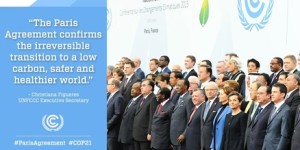 A total of 195 nations adopted the Paris Agreement on Climate Change—a historic pact to combat climate change and conduct actions and make investments towards a low-carbon, resilient, and sustainable future—on December 12, 2015 in Paris, France.
A total of 195 nations adopted the Paris Agreement on Climate Change—a historic pact to combat climate change and conduct actions and make investments towards a low-carbon, resilient, and sustainable future—on December 12, 2015 in Paris, France.
The agreement aims to keep global temperature rise this century well below 2 degrees Celsius and limit temperature increase even further to 1.5 degrees Celsius above pre-industrial levels, said an official statement released by the United Nations Framework Convention on Climate Change (UNFCCC).
Additionally, the agreement aims to strengthen the participating countries’ ability, particularly that of developing economies, to deal with the impacts of climate change.
The pact, reached after 13 days of grueling negotiations, intends to drastically change the way energy is produced and consumed on a global scale, reducing nations’ reliance on fossil fuels in favor of clean energy.
The deal called on the world to collectively cut and then eliminate greenhouse gas pollution but stopped at imposing sanctions on countries that don’t.
To reach these goals, financial support will be put in place to help developing countries achieve their own national objectives.
“The Paris Agreement allows each delegation and group of countries to go back home with their heads held high. Our collective effort is worth more than the sum of our individual effort. Our responsibility to history is immense,” said Laurent Fabius, president of the Conference of the Parties 21st Session (COP 21) UN climate change conference and French Foreign Minister.
The agreement identifies the crucial areas for nations to work on to curb global warming. These include:
- Mitigation – reducing emissions fast enough to achieve the temperature goal
- A transparency system and global stock-take – accounting for climate action
- Adaptation – strengthening ability of countries to deal with climate impacts
- Loss and damage – strengthening ability to recover from climate impacts
- Support – including finance, for nations to build clean, resilient futures
Countries are required to set long-term directions, cap their emissions, and continue to submit national climate action plans for addressing climate change.
“Countries will submit updated climate plans every five years, thereby steadily increasing their ambition in the long-term,” said a UNFCCC statement.
The agreement’s transparency and accounting system will provide clarity on countries’ implementation efforts, with flexibility for countries’ differing capabilities.
The efforts of developing countries to build their own clean, climate-resilient economies will be supported by scaled-up finance from developed countries and voluntary contributions from other countries.
Governments intend to ratchet up climate finance to US$100 billion by 2020, while also before 2025 setting a new goal on providing finance from the $100 billion floor.
The agreement includes a global stock-take starting in 2023 to assess the collective progress towards the goals of the agreement. The stock-take will be done every five years.
The pact likewise calls for a compliance mechanism, overseen by a committee of experts that operates in a non-punitive way.
International cooperation on climate-safe technologies and building capacity in the developing world to address climate change are also significantly strengthened under the new agreement.
Following the adoption of the Paris Agreement by the COP, it will be deposited at the UN in New York and be opened for one year for signature on April 22, 2016, Mother Earth Day.
Individual countries now must individually ratify or approve the agreement in their respective countries.
The agreement will enter into force after 55 countries that account for at least 55% of global emissions have deposited their instruments of ratification.





